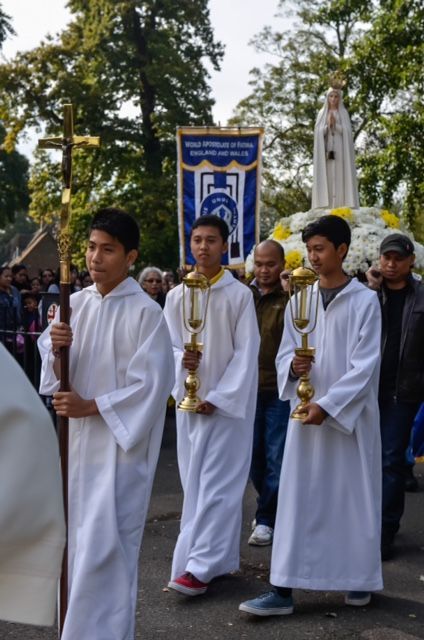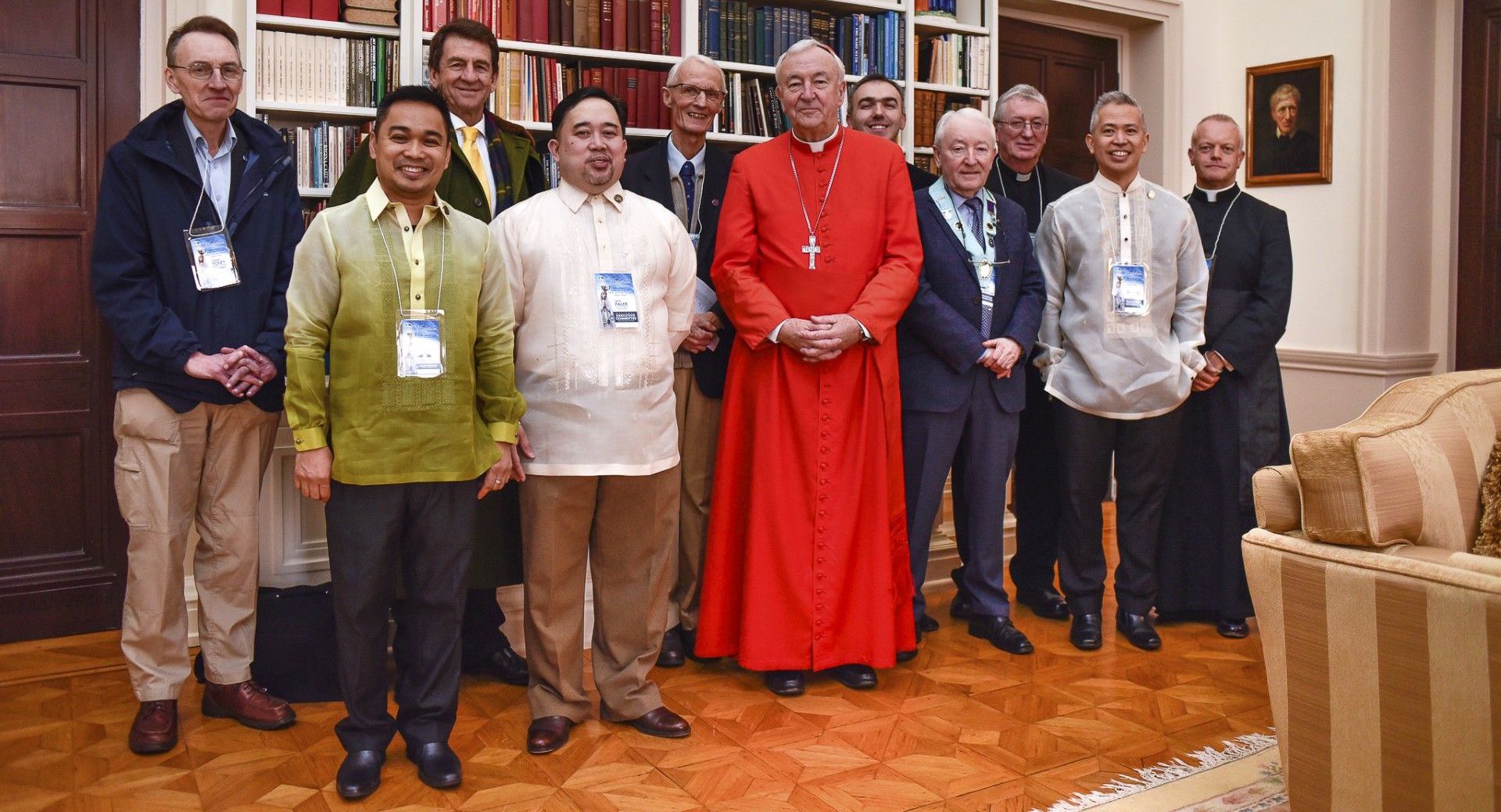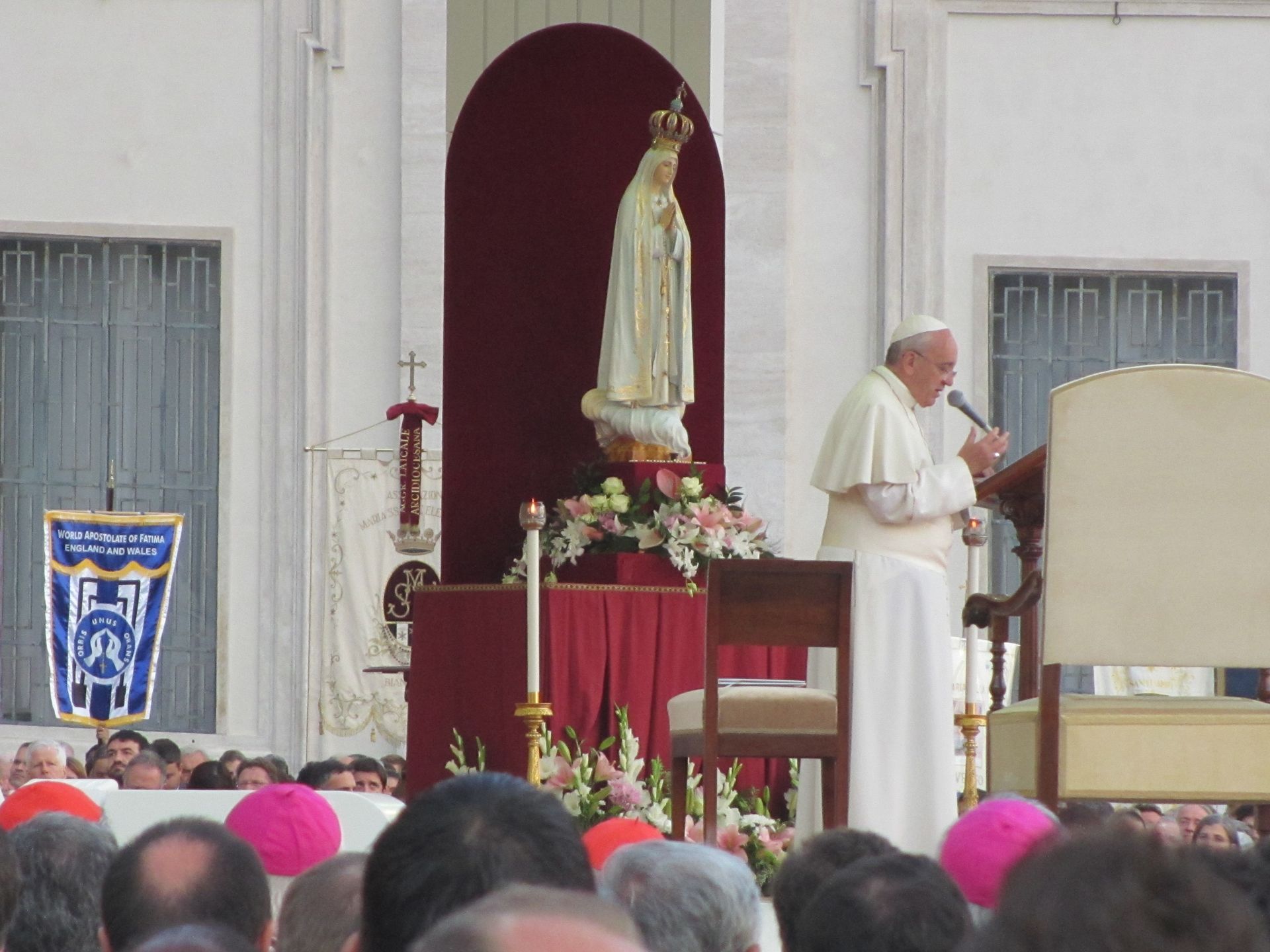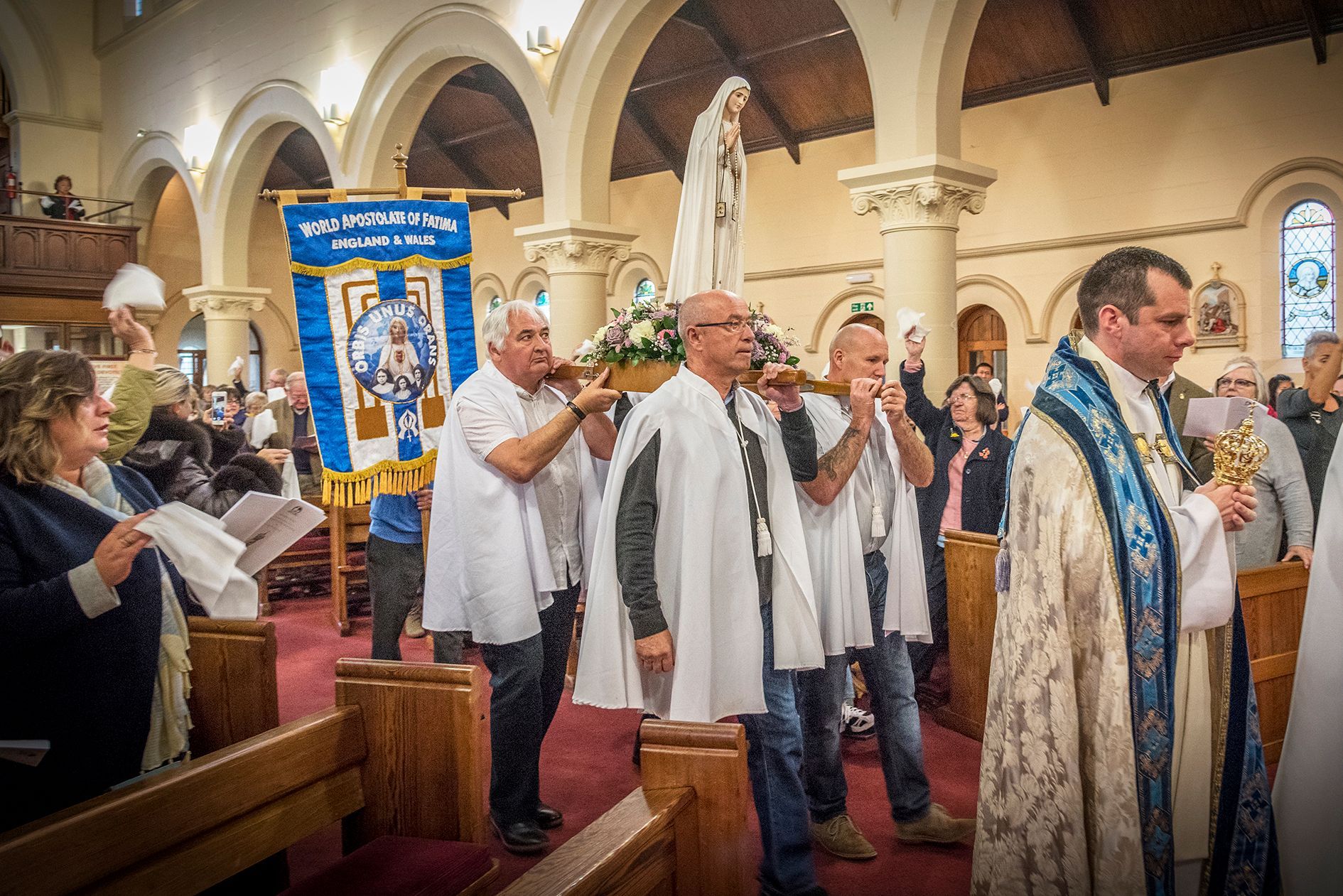The National Pilgrim Virgin Statue
The National Pilgrim Virgin Statue is a hand-carved Image of Our Lady of Fatima blessed by the Bishop of Fatima at the closing of the Jubilee Year on 13 May 1968, and brought to this country the following year.
The National Pilgrim Virgin Statue of Our Lady of Fatima, and Relics of Blessed Jacinta and Francisco has travelled around the country, visiting various Cathedrals and churches since 2017. This was the Centenary year of the Fatima message, which was given by the Blessed Virgin between May and October 1917.
The Pilgrim Virgin Statue was crowned at Walsingham, the National Shrine of Our Lady, by Bishop Alan Clark, Auxiliary Bishop of Northampton, on Thursday, 13 May, 1971, in the presence of more than one thousand people, with a crown specially blessed by His Holiness Pope Paul for the occasion.
When Pope John Paul II came to England in 1982, he blessed the National Pilgrim Virgin statue while at the Apostolic Nunciature in Wimbledon.
HISTORY OF THE STATUE
The idea of the “pilgrim” or “travelling” statue of Our Lady of Fatima began in 1947, after Cardinal Masella, the papal legate, crowned the original statue of Our Lady of Fatima as Queen of the World, on 13 May 1946, on behalf of Pope Pius XII. The Pope himself spoke to 800,000 pilgrims at Fatima by radio on this occasion saying: “Your ardent love, full of gratitude led you here, and you wished to give a tangible form to this love by symbolically representing it in that precious crown, which is the fruit of much generosity and of many sacrifices and with which we have now crowned the miraculous statue by means our Cardinal Legate” (There is Nothing More: The Blue Army’s Pledge to Our Lady of Fatima, p 325)
A youth Congress at Fatima the following year suggested the idea of carrying a copy of the statue processionally to Russia. Wonders occurred along the way. When the statue was in the Vatican, Pope Pius XII saw a re-enactment of the Miracle of the Sun which had taken place in Fatima in 1917.
Pope Pius XII said: “In 1946 I crowned her Queen of the World … and the following year, through this Pilgrim Virgin, she has gone forth as though to claim her dominions—and the favours she performs along the way are such that we can hardly believe what we are seeing with our own eyes.”
At first there were only four “official” Pilgrim Virgins. One was taken to Moscow in 1950, and enshrined there in the chapel of the American Embassy; a second travelled to the East; and a third to the West; and a fourth was blessed for the United Nations. Then in 1967, to commemorate the Golden Jubilee Year of Fatima and because in particular of a plea from Vietnam that the “Pilgrim Virgin may remain here until peace comes”, the Bishop of Fatima decided to bless special statues to remain permanently in each nation as “National Pilgrim Virgin Statue” and memorials of the Jubilee year. Twenty-five of these statues were delivered around the world. (There is Nothing More, p. 344.)
On 13 May 1971, the twenty-fifth anniversary of the coronation of Our Lady as Queen of the World by the papal Legate of Pius XII, Cardinal Masella, this symbolism was brought to a glorious climax when Bishops in 70 countries from all around the world simultaneously crowned National Pilgrim Virgin Statues to acknowledge Our Lady’s sovereignty over their individual countries as well as over the entire world. One of these coronations was at the National Shrine of Our Lady at Walsingham. (There is Nothing More, pages 347-48)
This took place in the presence of more than one thousand people. The Pilgrim Virgin Statue was crowned by Bishop Alan Clark, Auxiliary Bishop of Northampton, with a crown specially blessed by His Holiness Pope Paul for the occasion.
When Pope John Paul II came to England in May 1982 he stayed, while in London, at the Apostolic Nunciature in Wimbledon. The National Pilgrim Virgin was received at the Nunciature during this time and was blessed by the Holy Father.
FATIMA AFTER THE APPARITIONS
Meanwhile, work on the construction of the Capelinha, the Chapel of Apparitions, began on 28 April 1919 and was completed on 15 June; the first Mass was celebrated there on 13 October 1921. The pedestal on which the image of Our Lady stands in the Capelinha marks the exact spot where the little holm oak grew on which Our Lady appeared. In May 1922, Bishop Jose Correia da Silva of Leiria-Fatima, named a commission of enquiry to analyse the facts surrounding the Fatima phenomenon “with strictness and impartiality”.
On 10 December 1925, Sr Lucia, who had become a postulant with the Dorothean Sisters, was at their convent in Pontevedra, Spain, when she saw another apparition, this time of Mary with the Child Jesus. Mary told Lucia that she promised all the graces necessary for salvation to those who, on the first Saturday of five consecutive months, confessed, received Holy Communion, recited five decades of the rosary, and meditated on the rosary for fifteen minutes, all with the intention of making reparation to her Immaculate Heart.
Meanwhile, on 13 January 1924, Mass was celebrated for the first time inside the Capelinha, while on 26 June 1927, the bishop presided for the first time at an official event—the inauguration of the 14 kilometre Way of the Cross to the Cova da Iria, where he celebrated Mass in the presence of 400 pilgrims. Building work on he Basilica of Our Lady of the Rosary of Fatima was begun in 1928, and it was consecrated on 7 October 1953. It has 15 altars dedicated to the 15 mysteries of the Rosary. The bodies of Jacinta and Francisco were moved to their present positions, to the left and right of the main altar, in the early 1950s, and Sr Lucia’s body was interred in the Basilica in 2008 next to Jacinta’s. The mortal remains of Bishop Correia da Silva, who died in 1957, are interred in the Chancel.
Prior to this, on 13 June 1929 Sr. Lucia, while at prayer in the convent chapel at Tuy, saw a vision of the Most Holy Trinity, with Mary standing on the altar displaying her Immaculate Heart in her left hand. It was on this occasion that Mary asked the Pope, in union with all the bishops of the world, to make the [collegial] consecration of Russia to her Immaculate Heart that she had announced during the July 1917 apparition.
On 13 October 1930 the Bishop issued a pastoral letter on the apparitions, which, after recounting the events at Fatima, contained the following brief but important statement:
“In virtue of considerations made known, and others which for reasons of brevity we omit; humbly invoking the Divine Spirit and placing ourselves under the protection of the most Holy Virgin, and after hearing the opinions of our Rev. Advisors in this diocese, we hereby:
- Declare worthy of belief, the visions of the shepherd children in the Cova da Iria, parish ofFatima, in this diocese, from the 13th May to13th October, 1917.
- Permit officially the cult of Our Lady of Fatima.”
In thanksgiving for this development, six months later, on 13 May 1931, a vast pilgrimage of around 300,000 people came to Fatima to participate in a ceremony presided over by Cardinal Cerejeira, Patriarch of Lisbon, at which all the bishops of Portugal made the first consecration of their country. It was this consecration, and that of 1938, which preserved Portugal from the violent attack on the Church in the Spanish Civil War, and its renewal in 1940 saved Portugal from being dragged into the horrors of the Second World War.
Fatima developments from World War II onwards
On 31 October 1942, during World War II, Pope Pius XII, speaking in Portuguese by radio, consecrated the world to the Immaculate Heart of Mary, with a special mention of Russia, in response to the request he had received in a letter from Sr Lucia. Some months later Sr Lucia said that as a result of this act, God promised to end the war soon.
On 13 May 1946, Cardinal Masella, the Papal Legate, crowned the Statue of Our Lady of Fatima in the Capelinha as Queen of Peace. This crown was made from gold melted down from wedding rings donated by the women of Portugal, and it also contains over 4,000 precious stones, which they contributed in thanksgiving for Portugal having been spared the horrors of the Spanish Civil War and the Second World War.
On 13 October 1951, Cardinal Tedeschini, who was in Fatima for the closing of the Holy Year, revealed that in October 1950, at the time when he had promulgated the dogma of Mary’s Assumption into heaven, Pope Pius XII had witnessed a repetition of the solar miracle of 13 October 1917, while he was walking in the Vatican gardens.
Cardinal Roncalli, the Patriarch of Venice, and the future Pope John XXIII, presided at the ceremonies at Fatima on 13 May 1956, while, on 21 November 1964, Pope Paul VI, at the conclusion of the third session of the Second Vatican Council, proclaimed “the Most Blessed Mary Mother of the Church”; the Pope also considered it was “particularly opportune” to recall Pius XII’s consecration of the world to the Immaculate Heart of Mary; and bearing that consecration in mind, he announced before the 2,500 Council Fathers, that a Golden Rose was to be presented to the Sanctuary of Fatima (this act was carried out on 13 May 1965 by Cardinal Cento, the Papal Legate); and the Pope concluded his address by proclaiming, “to your Immaculate Heart, O Mary, we commend the entire human race”.
Pope Paul VI came to Fatima on 13 May 1967 to celebrate the 50th anniversary of Our Lady’s first Apparition, and to pray for world peace and Church unity. In a significant sign of papal approval for the message of Fatima, the Pope invited Sr Lucia to join him on the external altar in front of the crowds, and in his Apostolic Exhortation Signum Magnum, issued on the same day, Paul VI urged “all members of the Church to consecrate themselves once again to the Immaculate Heart of Mary and to translate this pious act into their daily lives”.
Ten years later, on 10 August 1977, the future Pope John Paul I, Cardinal Luciani, Patriarch of Venice, came on pilgrimage to Fatima.
UK HEADQUARTERS
World Apostolate of Fatima
Headquarters
International UK phone
Email:
Skype
PARISH ACTIVITIES






